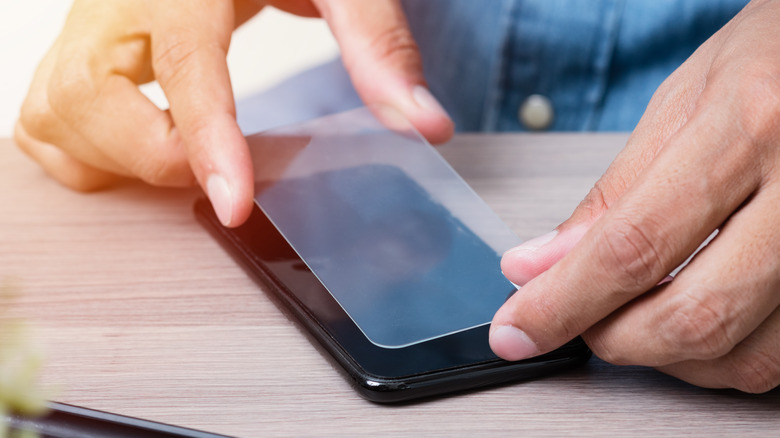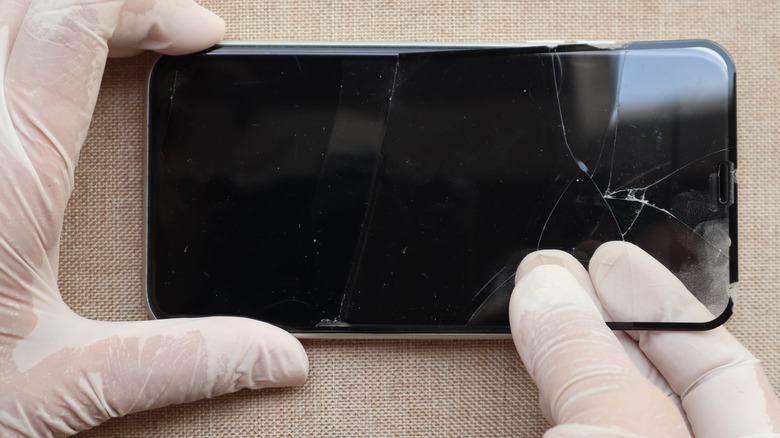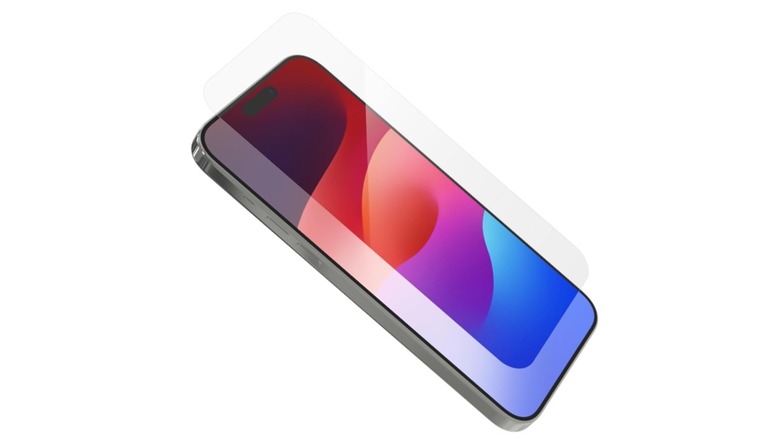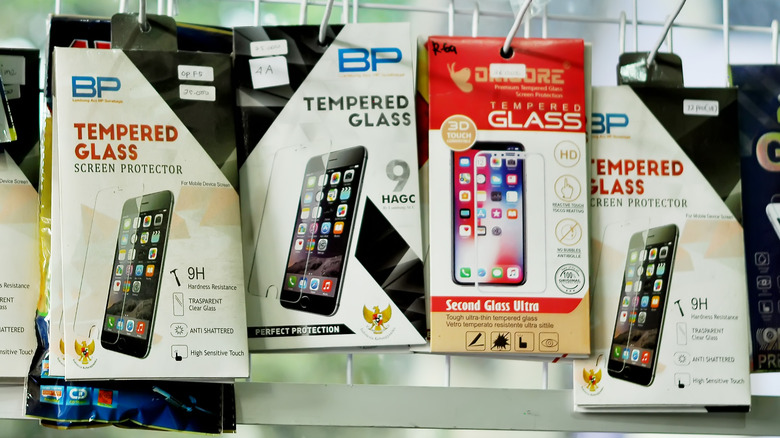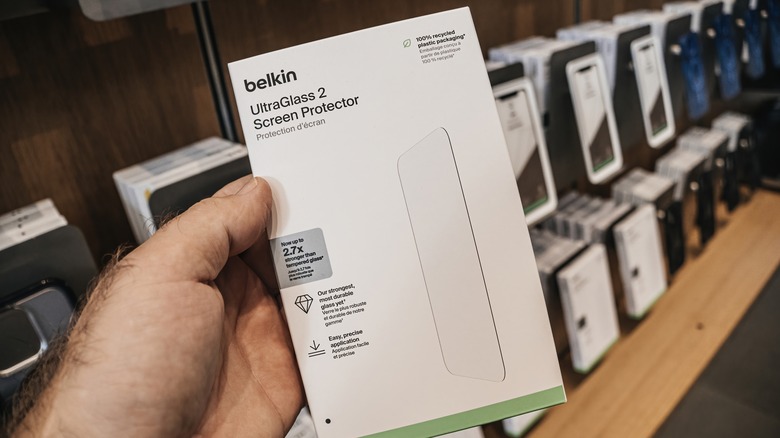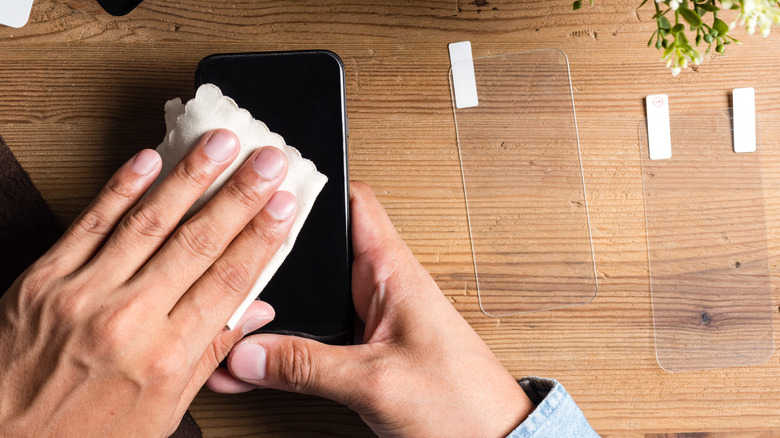Matte Vs. Glossy Screen Protectors: Which Is Right For Your iPhone?
The iPhone 12 and later come with Apple's "Ceramic Shield" display, a glass-ceramic that claims to offer four times better drop protection than previous iPhones. While your iPhone display can pick up small scratches with daily use, it's surprisingly strong, and if you use a case with raised bumpers, you might not need a screen protector at all.
Some people prefer to have the added protection, though — either because they don't want to risk cracking or scratching their screen, or because they want to preserve the display for when they sell or trade in their iPhone.
Choosing a good quality screen protector makes all the difference, and you should always buy a screen protector from a reputable brand if you want the best protection to preserve the iPhone's screen. You'll also need to decide what type of screen protector you want.
Glossy screen protectors are the most common, mimicking the crystal clear glass of your display. Alternatively, you can opt for a matte screen protector if you prefer a more muted screen. Both matte and glossy screen protectors have their own advantages, but which one you choose will ultimately come down to your needs and wants.
What are glossy screen protectors?
Glossy screen protectors preserve the clarity of your iPhone's display, and you can get them in plastic film or tempered glass options.
Plastic screen protectors are made of PET (Polyethylene Terephthalate) or TPU (Thermoplastic polyurethane). PET screen protectors provide the most basic protection, adding an anti-scratch layer to your screen. They're extremely thin and also have the advantage of being cheap.
TPU screen protectors are more durable, and can protect your screen from minor drops. Due to their elastic nature, they have limited self healing abilities. That means that small scratches and bubbles can fade away after a day.
The downside is they are difficult to install, requiring the use of wipes and a scraping tool to get the bubbles out of the screen protector. Both PET and TPU screen protectors can offer edge-to-edge protection, and due to their thin nature, don't impact the touch responsiveness of your screen.
If you want the most protection for your iPhone screen though, tempered glass screen protectors are the best option. You should look for tempered glass that has a hardness rating of 9H on the Mohs scale. While these screen protectors can shatter, they safeguard your screen from cracking in the process.
Despite being thicker than film-type screen protectors, tempered glass screen protectors offer good clarity. In addition, many come with an alignment tool in the box that makes them easy to apply.
What are matte screen protectors?
Most smartphones and laptops feature glossy screens, but you can find matte screens on some devices, such as the Amazon Kindle or computer monitors. A matte screen is usually made of plastic, and the effect is achieved by micro-etching the screen, effectively creating tiny indentations that you can't see.
As a result of this etching, matte screens diffuse light, making them less reflective than glossy screens — ideal for harshly-lit office environments and outdoor usage. Matte screen protectors serve the same function as matte screens. They are frequently labeled as anti-glare screen protectors, since that's their primary purpose. Many users also love the soft, silky feel of matte screen protectors.
As a result of the etching process, matte screen protectors are smudge-proof, so if you hate seeing fingerprints all over your phone's display, they can be a gamechanger. Like glossy screen protectors, you can get matte screen protectors as films or glass. The former is good for protection against scratches, while the latter makes more sense if you want drop protection.
Glossy vs. matte screen protectors: Prices compared
Since glossy screen protectors are more popular than matte, they make up the bulk of iPhone screen protectors that are available. As a result of this, you can get glossy glass and plastic screen protectors for very cheap on Amazon.
For example, this amFilm screen protector for the iPhone 15 includes two tempered glass screen protectors (9H hardness), two camera lens protectors, and an installation kit for under $10 — and is even on sale for $6 on Black Friday, a 40% discount.
Not all glossy screen protectors are cheap, though. If you opt for one from premium brands like Belkin, Spigen, and Caseology, you'll have to spend significantly more. For example, this iPhone 15 Pro tempered glass screen protector from Spigen is usually $35 for a two-pack ($16 for Black Friday) — more than three times the price of the amFilm option.
Since there's less demand for matte screen protectors, the options are significantly fewer, and many appear to be generic matte screen protectors that have been rebranded. As a result, prices are less varied.
A single pack matte screen protector tends to be priced under $7, while a two-pack, like this iPhone 15 Pro Max matte glass screen protector from Mothca, goes up to $15.
Which brand of screen protector should you buy?
If a cheap price is your main consideration, you can pick up a screen protector from a generic brand. While this will do the job, you might have issues with quality. For example, cheap film type screen protectors may have low quality adhesives that cause them to peel around the edges over time, while tempered glass options might not be hard enough to withstand a drop.
If you want the best screen protector for your iPhone, you'll need to opt for an established brand, even if you don't want an expensive option. When it comes to glossy screen protectors, the most premium options come from brands like Belkin, Otterbox, ZAGG, CaseMate and Spigen.
If you want to spend less than $20, consider brands like Dbrand, Caseology, and ESR. If you want something under $10, amFilm, Ailun, and Supershieldz are reputable options.
There are far fewer brands to choose from if you want a matte screen protector. Supershieldz is probably your best bet when it comes to matte screen protectors, and it's quite affordable, too. Mothca is another brand that's known for its matte screen protectors.
If you want a premium matte screen protector, ZAGG is one of the few brands that makes them, but be prepared to spend upwards of $40.
Glossy vs. matte screen protectors: Which is better?
Glossy screen protectors offer more clarity, and are therefore ideal if you watch a lot of movies and play games on your phone. They're also the better choice if you enjoy browsing through social media apps like Instagram or photo editing, mainly because they preserve the color saturation and contrast of your iPhone screen.
Matte screen protectors, on the other hand, are a better option if you spend a lot of time outdoors. Since these are less reflective, you'll be able to view your screen even in harsh lighting.
This also makes it easy on the eyes, so if you like to read on your iPhone, you might prefer a matte finish to protect your eyes. Matte screen protectors also make more sense if you want to avoid fingerprints and smudges on your phone screen.
There's no best option when it comes to choosing between matte and glossy screen protectors. Both have their advantages and disadvantages, and ultimately, your choice of screen protector comes down to your iPhone usage and preference.
